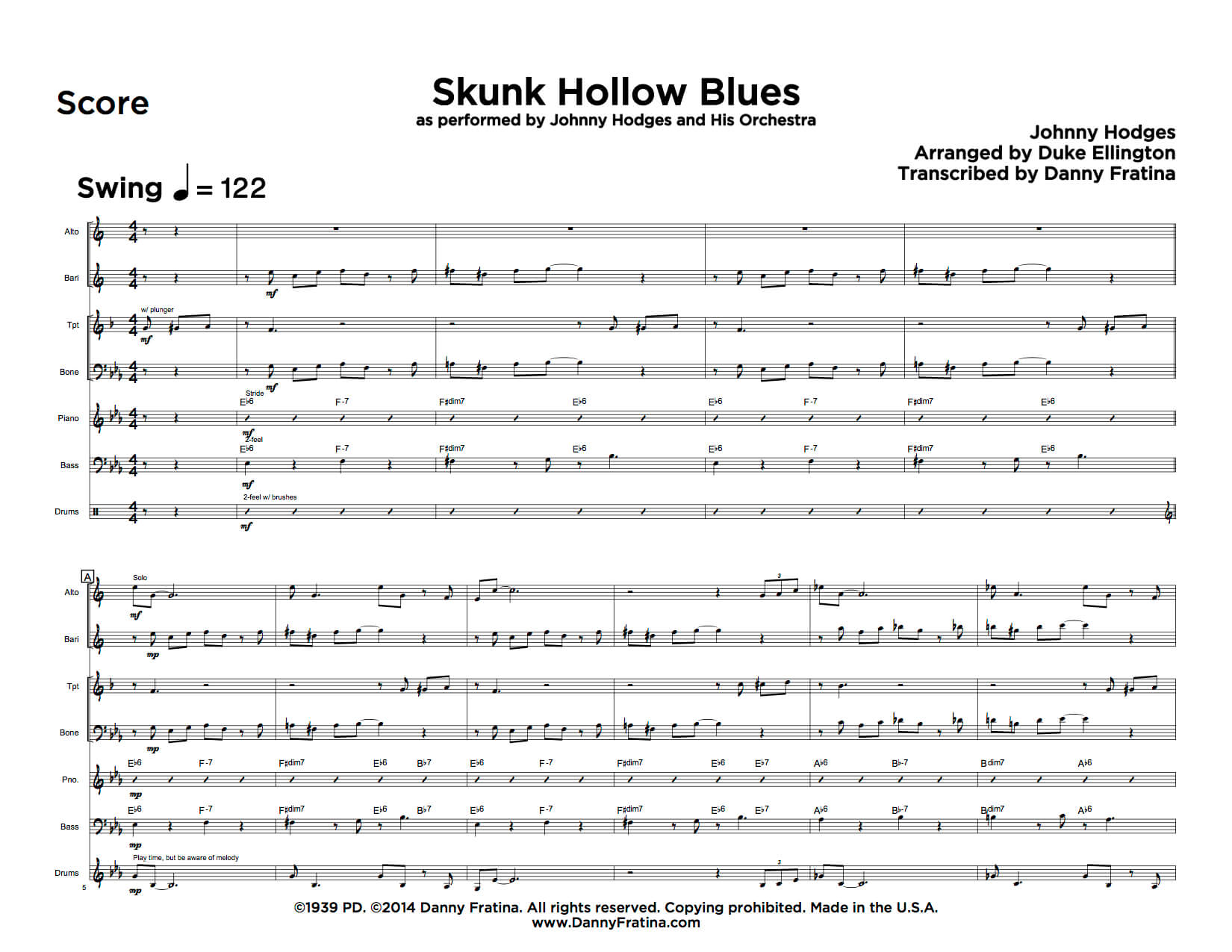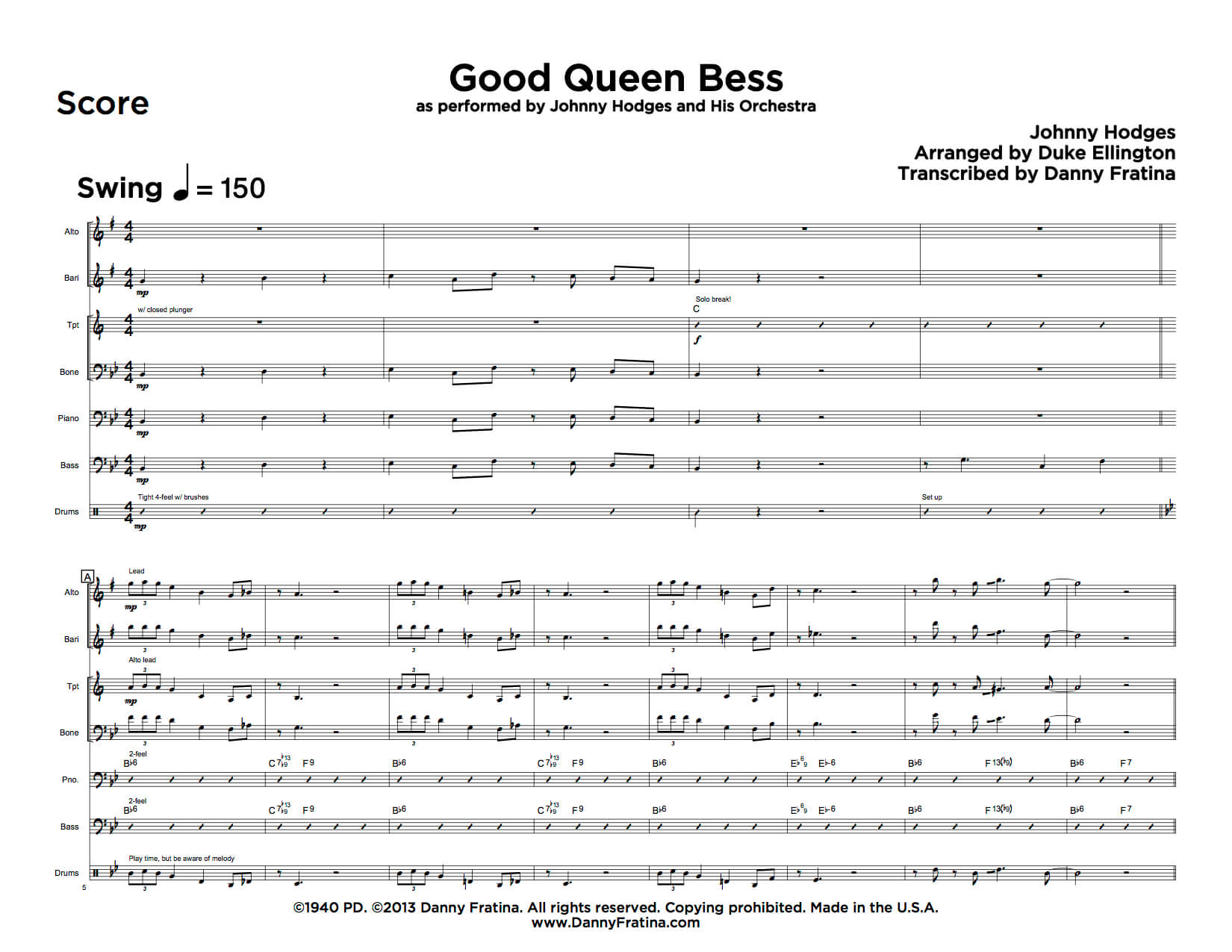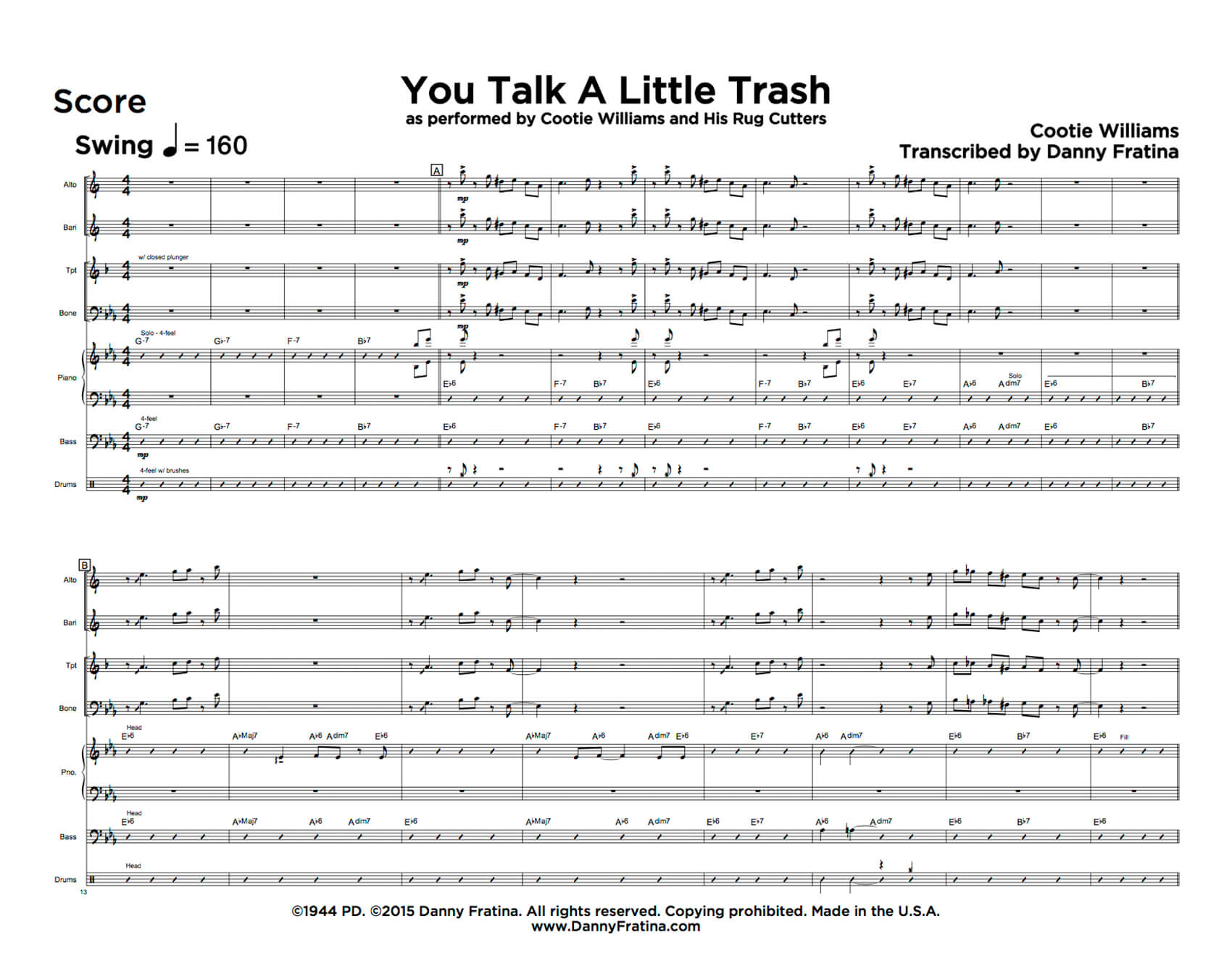“Good artists borrow, great artists steal.”
This quote is often attributed to Igor Stravinsky, a composer who was heavily inspired by Duke Ellington’s music and who’s music Ellington himself was an admirer of. It’s appropriate here not just because of the connection between the two composers, but because of the intention of the quote itself – the process of “stealing” from your favorite composer and reusing it in your own context is one of the best learning methods to help you build a solid compositional foundation.
Let’s look at three arranging techniques we can use to reproduce the sound of the Ellington/Hodges band. Of course, you could copy out a score note by note and never truly reproduce the sound without the vital element of the players themselves! Nevertheless, let’s get as close as possible:
1. Riffs and Repetition
Riffs make up a good portion of written material in these arrangements, both on the head melody and as backgrounds. A good head riff can be very catchy and swing hard, but as an arranger it can also fill up the sound (in unison or voiced out) and get you a lot of mileage without needing to really do very much. You can come up with a simple riff and let it repeat to it’s natural conclusion and you’ve got almost a chorus of sound that doesn’t overwhelm, doesn’t outstay it’s welcome, and stylistically fits perfectly.
The head of The Intimacy Of The Blues is a great example of getting more bang for your buck. The melody is a great traditional blues riff (statement, repeated statement, resolution) and the triplet figure inside of it makes a great background riff under the solos.
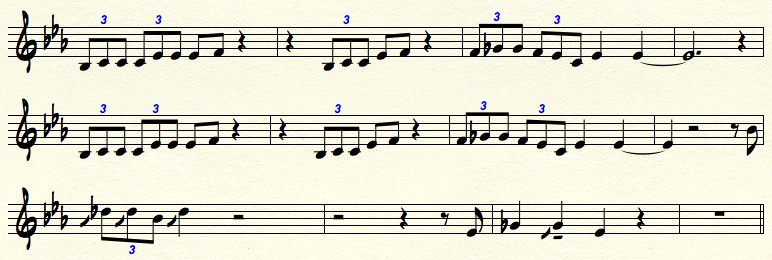

The backgrounds of Who Struck John are also very simple and blues-based; they consist of only two pitches, but are incredibly effective.
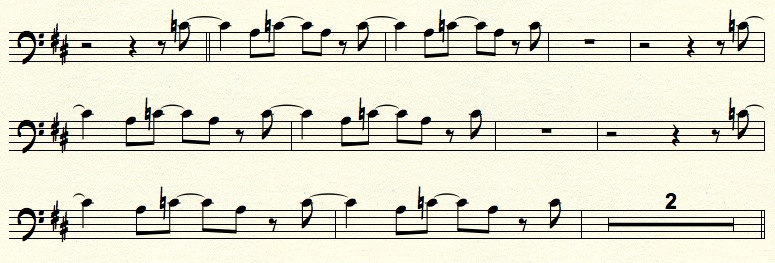
What to steal
The simplicity and catchiness of Ellington’s riffs. They are often blues-based, though few hammer you over the head with the “blues notes.” Plant small creative seeds early on, be patient with your chart and reuse material, and allow it to flourish.
2. Chord Progressions and Form
Ellington at this time seemed to favor several common chord progressions or pieces of progressions and they make great foundations for your own tunes.
The blues is an easy one. Ellington often kept his blues chord progressions fairly simple and didn’t spice them up with reharmonization. He would use the horn voicings to get the modern sound he wanted while keeping the basic jazz traditions underneath it all.
Rhythm changes is also a very simple one. There are countless variations on this, but usually they were simplified and very functional. Often times in bar 5 and 6 he would have I6 V7/IV | IV6 IV-6 – which makes for great melodic possibilities and great voicings (that have built-in melodic motion!). Rhythm changes are also ripe for riff writing. His bridges ranged from traditional extended dominant pattern to something more bluesy with IV7s. These are great moments for modern voicings.

What to steal
Rip off the chord progression of a tune you like and build something new on top of it. You want to stick with functional harmony and avoid modern sounds like multi tonic systems, modal harmony, and nonfunctional stuff, etc. Chord progressions are not copyrightable and you can never get in any kind of trouble for copying them. There is nothing hackneyed or ignoble about this: every composer after Gershwin has used rhythm changes and tons of early bebop tunes were new melodies over familiar changes (for example, Charlie Parker’s “Ornithology” is written over the changes of “How High the Moon”).
A good list of some famous examples can be found here – http://en.wikipedia.org/wiki/List_of_jazz_contrafacts
3. Voicings – Three Part Triads and Spreads
Here is where we get into some real meat and potato stuff. When you have four horns that have fairly flexible ranges and one drops out to take a solo, it’s natural to want to use the three remaining horns to form triads – three-note voicings stacked in 3rds (in various inversions and drops).
If you are on a C6 chord, find your melody note of choice, let’s say A in the trumpet, and voice down to make a triad, so Bone E and bari C. Notice that if we were to give the bari a G, the 5th of the chord, we might be picking a (theoretically) slightly more interesting note, but we lose the ability to punch through with the power of a tight triad.

Why the triad? It has power and simplicity. Unlike a spread, which calls attention to a wider sound and the individual horns, a triad is a team effort that washes away some of the individuality in favor of the greater good of the triad, like a musical battering ram. There is a reason why the triad was the standard-bearer of chord structures for hundreds of years!
Besides triads, Ellington was also one of the earliest jazz composers to use spreads. Spreads would see more widespread usage after appearing all over the Miles Davis 1949 album “The Birth Of The Cool,” and since then they have set the starting point for jazz composition education. Ellington was doing it over a decade before John Lewis and Gerry Mulligan brought it into the world of bop and it’s surprisingly simple to construct.
The simple 3-part spread in the Ellington 7-Piece usually uses bari sax, trombone, and either trumpet or alto. To start, the bari and bone each get one of two guide tones. This is a fairly mechanical step because there are only a couple of ways to go here, based on range, what music is before and after the voicing, low interval limits, and other factors. Guide tones are the 3rd and 7th (or 6th), notes which define the quality of a chord assuming a bassist is present (and one always is on these recordings). The guide tones for a CMaj7 would be E and B. For a C7, E and Bb. For C-7, Eb and Bb. Etc etc.
So give those two guys the guide tones in comfortable registers and give the remaining instrument (tpt or alto) a third note on top of them, usually a chord tone (root or 5th) or a tension (9/11/13). This 3-part spread is quite modern sounding and very effective at defining chord sound, giving independence to each player, and capturing the listener’s ear. It can give the soloist a creative boost by giving him some different sounds to react to. They work best when used on notes of longer duration.


What to steal
The triad and 3-part spread techniques, straight up. Just do it and get used to the challenges using each technique creates. Finding context for when to use what and how best to harmonize a melody is what voicings are all about (See above example of mixed voicing techniques that ultimately create the best music). Voicings don’t exist in a vacuum – we can analyze them all the live long day, but until you put them into a tune and hear how they sound and make note of why some sound good and others bad, you’ll never be able to understand the fact that the music came first and the “theory” came after.
Using these ideas over and over until you get comfortable with them will give you the ability to write 4-horn charts just like Duke, like you are a compositional Mega Man! After you have mastered this format, take your new skills and use them to effortlessly write in your own style, finding your own voice as a writer and arranger. “Stealing” in the music works the same as “stealing” in physics or engineering, where in those fields you aren’t “stealing” formulas or techniques, you are learning a method to recreate something standard. “Stealing” isn’t about being lazy or unimaginative, it’s about lassoing time-tested fundamentals, putting them into PRACTICAL use (as opposed to theoretical), and absorbing a musical tradition that acts as a basic foundation for your own creativity!
